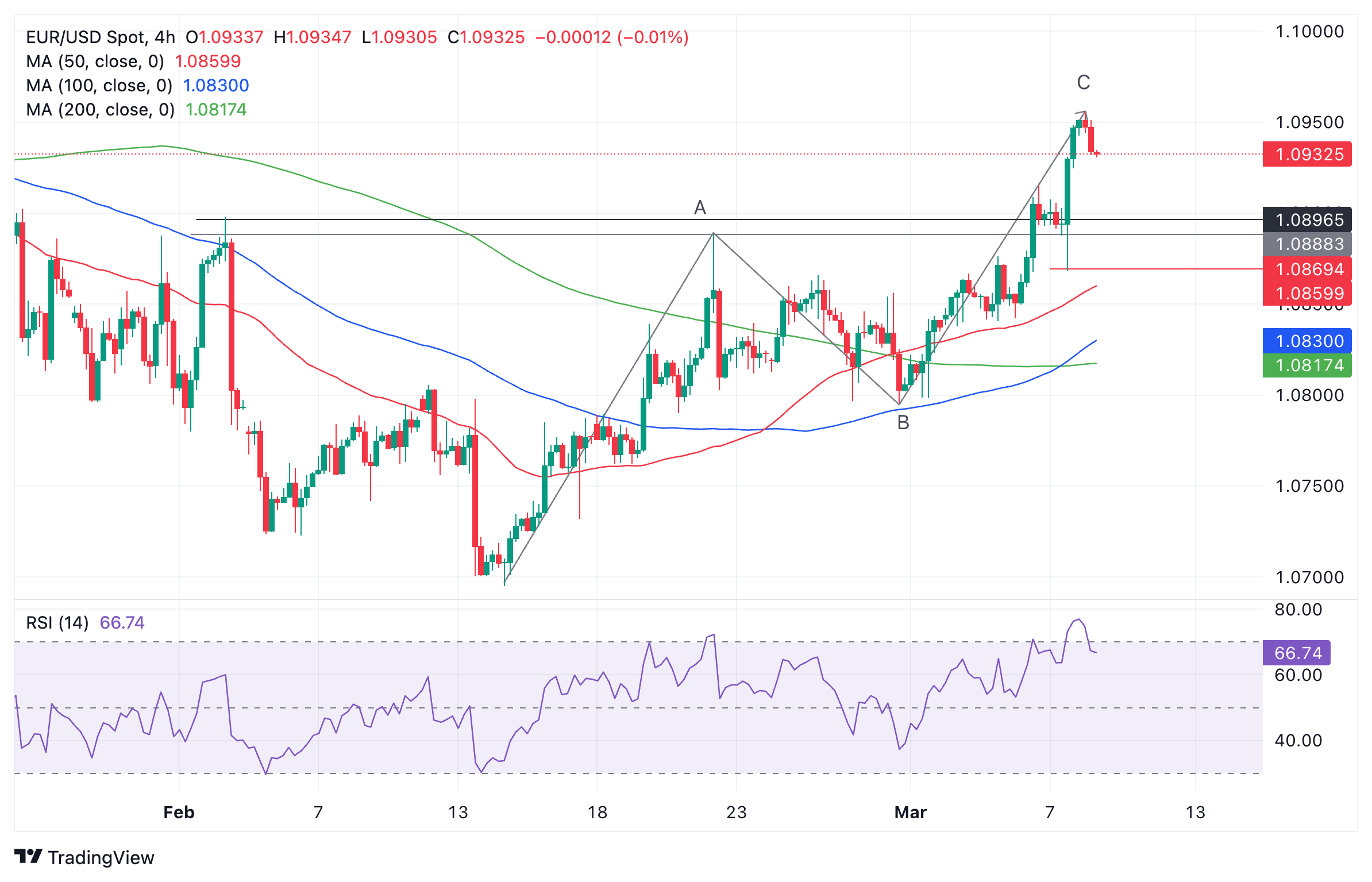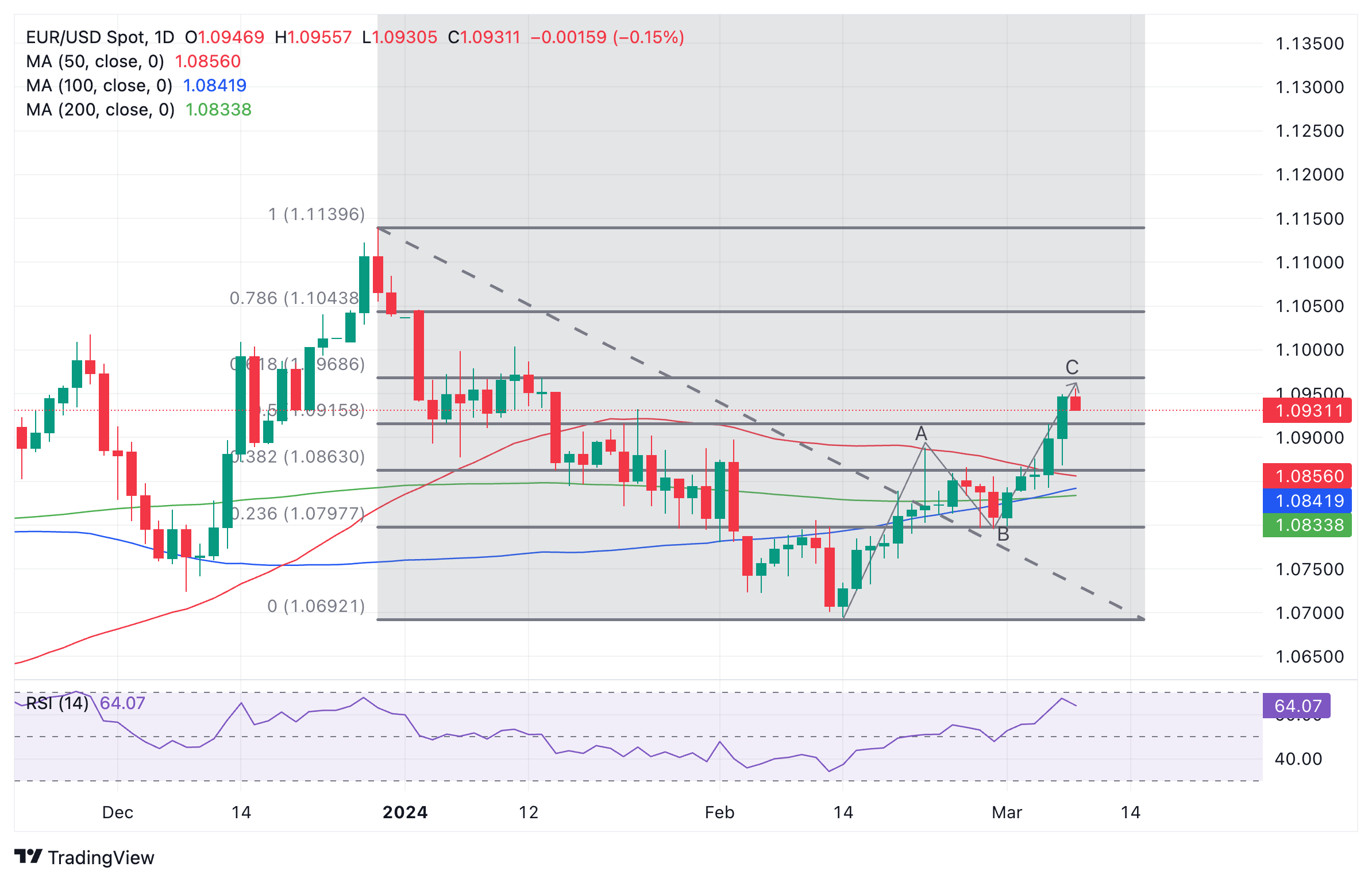EUR/USD surges after the release of US Nonfarm Payrolls

- EUR/USD rallies to high of the day after the release of US Nonfarm payrolls weakens US Dollar.
- Unexpected falls in Average Hourly Earnings and the Unemployment Rate weigh on USD.
- Comments from ECB officials have revived the possibility of an early rate cut, pressuring the Euro.
EUR/USD rises up to touch the highs of the day in the 1.0970s on Friday after the release of US Nonfarm Payrolls shows disinflationary wage data and a suprise rise in the Unemployment Rate in February.
The EUR/USD rebounds after edging lower after comments from ECB officials put the possibility of an early interest-rate cut in April back on the table.
EUR/USD rebounds after Nonfarm Payrolls
The EUR/USD awoke from its slumber and shot up on Friday after the release of US Nonfarm payrolls showed an unforeseen fall in Average Hourly Earnings and rise in the Unemployment Rate, that suggest the Federal Reserve (Fed) may begin cutting rates earlier than previously expected.
Whilst the headline NFP figure showed the economy adding 275K jobs in February, which was higher than the 200K expected, the other data in the Bureau of Labor Statistics (BLS) report suggested weaknesses in the labor market.
Average Hourly Earnings, which are a key component of inflation, rose by a lower-than-expected 4.3% YoY and 0.1% MoM. Both were below the 4.4% and 0.3% predicted. The Unemployment Rate, meanwhile, rose to a higher-than-expected 3.9% when it had been expected to stay put at 3.7%.
The data suggests less inflationary pressure from wages and low unemployment which could prompt the Fed to bring forward interest rate cuts to earlier in the year. Lower interest rates are negative for the Dollar as they reduce foreign capital inflows.
Euro pressured by comments from ECB officials
The Euro has been hit on Friday after Governor of the Bank of France and ECB Governing Council member Francois Villeroy de Galua, said a rate cut in spring was now “very likely”, adding, “spring goes from April to June.”
His ECB colleague, Bundesbank President Joachim Nagel, said “The probability is increasing that we could see an interest-rate cut before the summer break,” adding, “This will be data dependent, but the prospects have brightened.”
Their dovish views clash with the more cautious stance of the ECB President Christine Lagarde, who said after the ECB meeting on Thursday, that June would be the next key date for reviewing policy on interest rates. The Euro is declining as lower interest rates reduce the attractiveness of a currency as a place for foreign investors to park their capital.
EUR/USD is broadly speaking in a short-term uptrend, propelled higher by prospects that the US Federal Reserve (Fed) is a fraction closer to lowering interest rates than the European Central Bank (ECB).
Technical Analysis: Euro recovers after pulling back
Turning to the charts, the EUR/USD has risen up to the 1.0900s from February’s base-camp 1.0600 lows. The sequence of rising peaks and troughs suggests that overall a tentative short-term uptrend is in progress, slightly favoring bulls.
There are, however, signs a pullback could be unfolding. The Relative Strength Indicator (RSI) has exited the oversold zone, giving a sell signal. At the same time, the pair may have completed a three-wave ABC measured move pattern at the recent 1.0956 highs. This is further evidence a correction may be underway.
Euro vs US Dollar: 4-hour chart
Whilst these signs are still not enough to indicate a reversal of the short-term uptrend, they do recommend a pullback is underway. The most likely target for the correction to find support is in a zone between the 1.0898 February 2 high and the top of the A wave at 1.0888.
A break below the red line at Thursday’s 1.0867 lows would indicate a greater chance the pair was reversing.
The daily chart shows the pair is also probably now in an intermediate uptrend, although one pass higher after the current pullback would solidify that view.
Euro vs US Dollar: 1-day chart
The RSI on the daily chart is not as overbought as on the 4-hour and indicates more upside is still possible before the party gets too rowdy.
The next target higher if the uptrend resumes is the key 0.618 Fibonacci retracement of the early 2024 decline, at 1.0972.
A break above that level would further encourage bulls to strike for the prize – 1.10 – an important psychological level, followed by 1.1043 at the 0.786 Fibonacci retracement.
A break beneath the 1.0795 lows would spoil the buyer’s party and indicate a vulnerability to break down.
The overall long-term trend is sideways and remains difficult to forecast.

